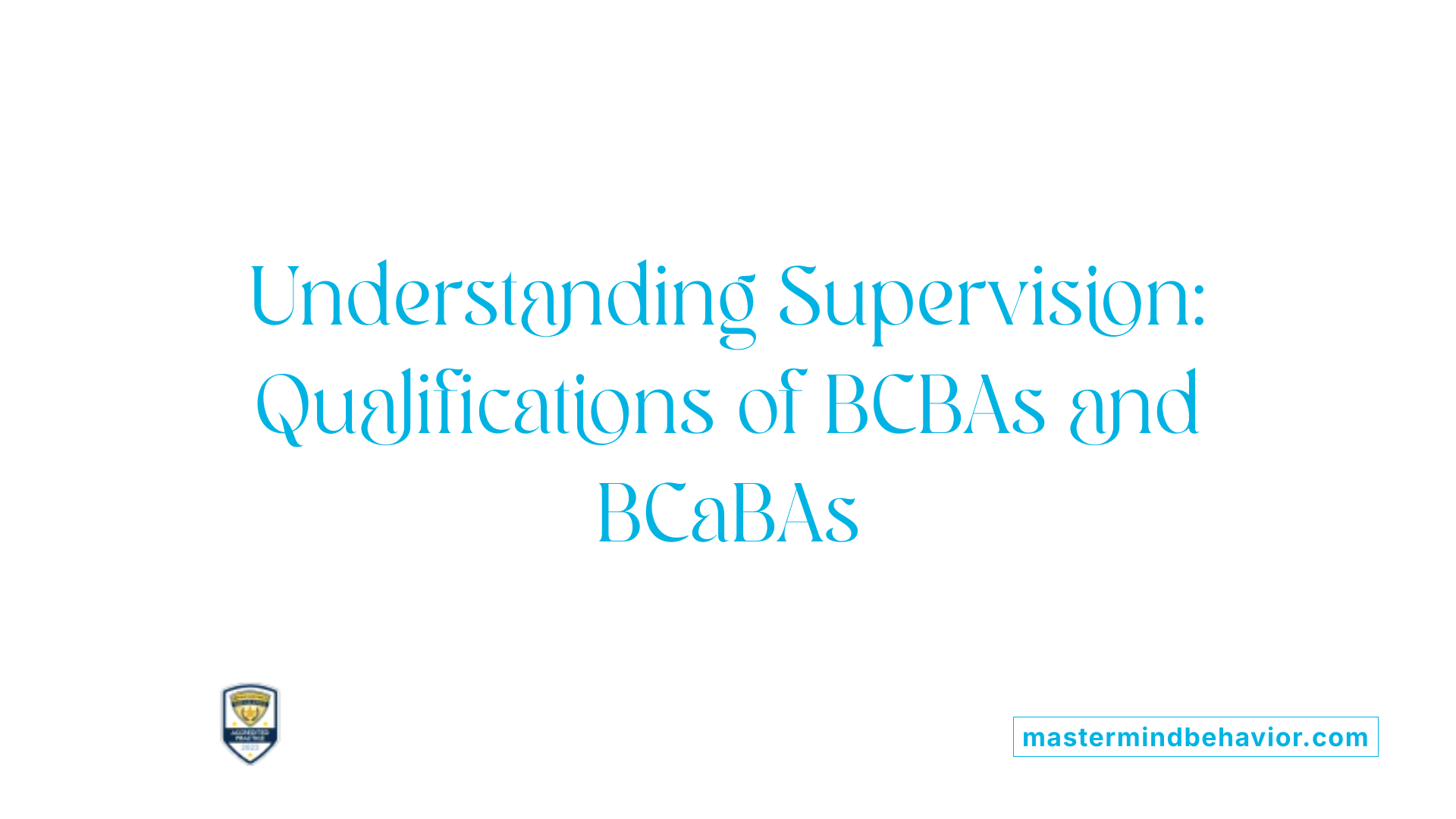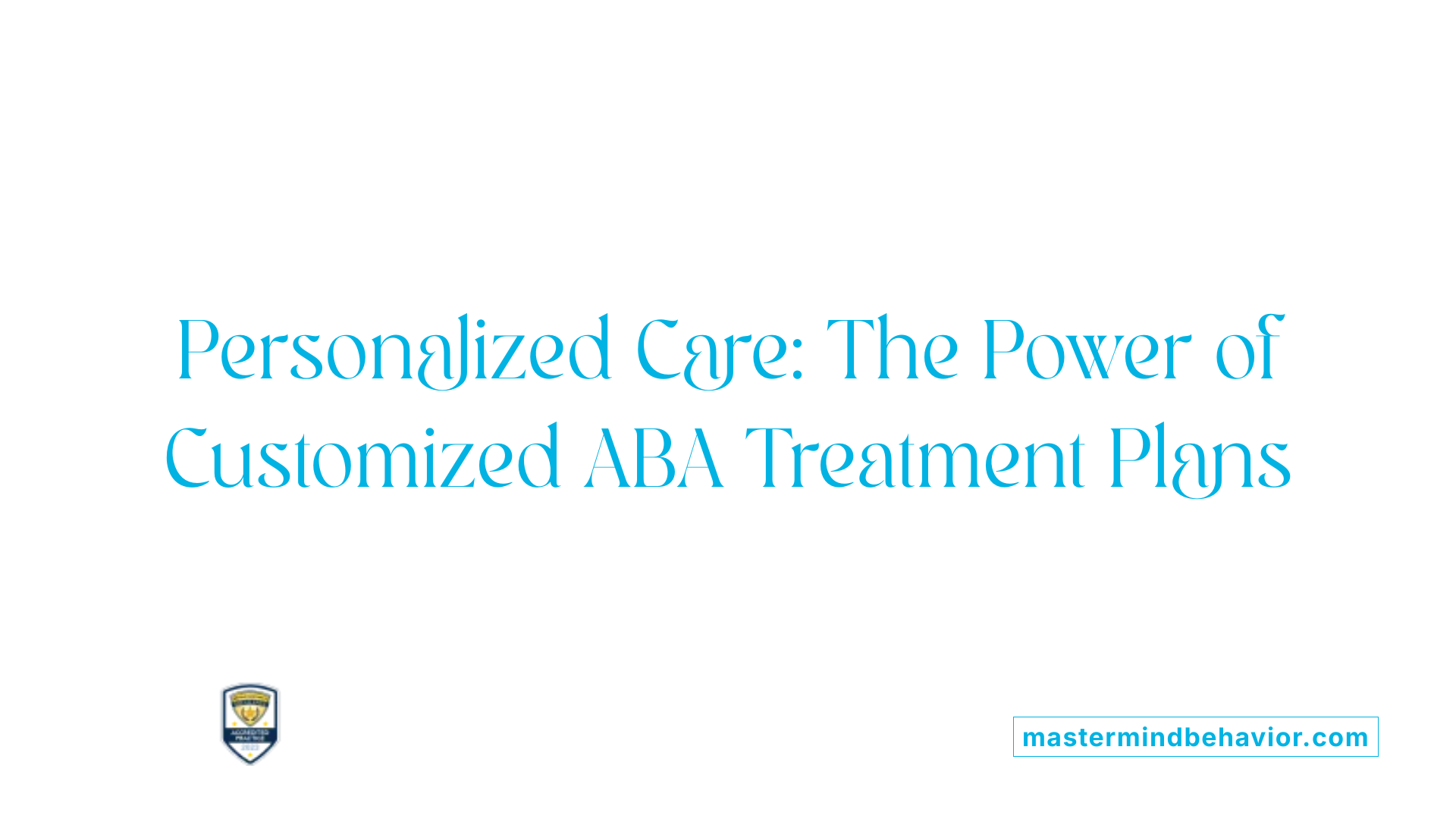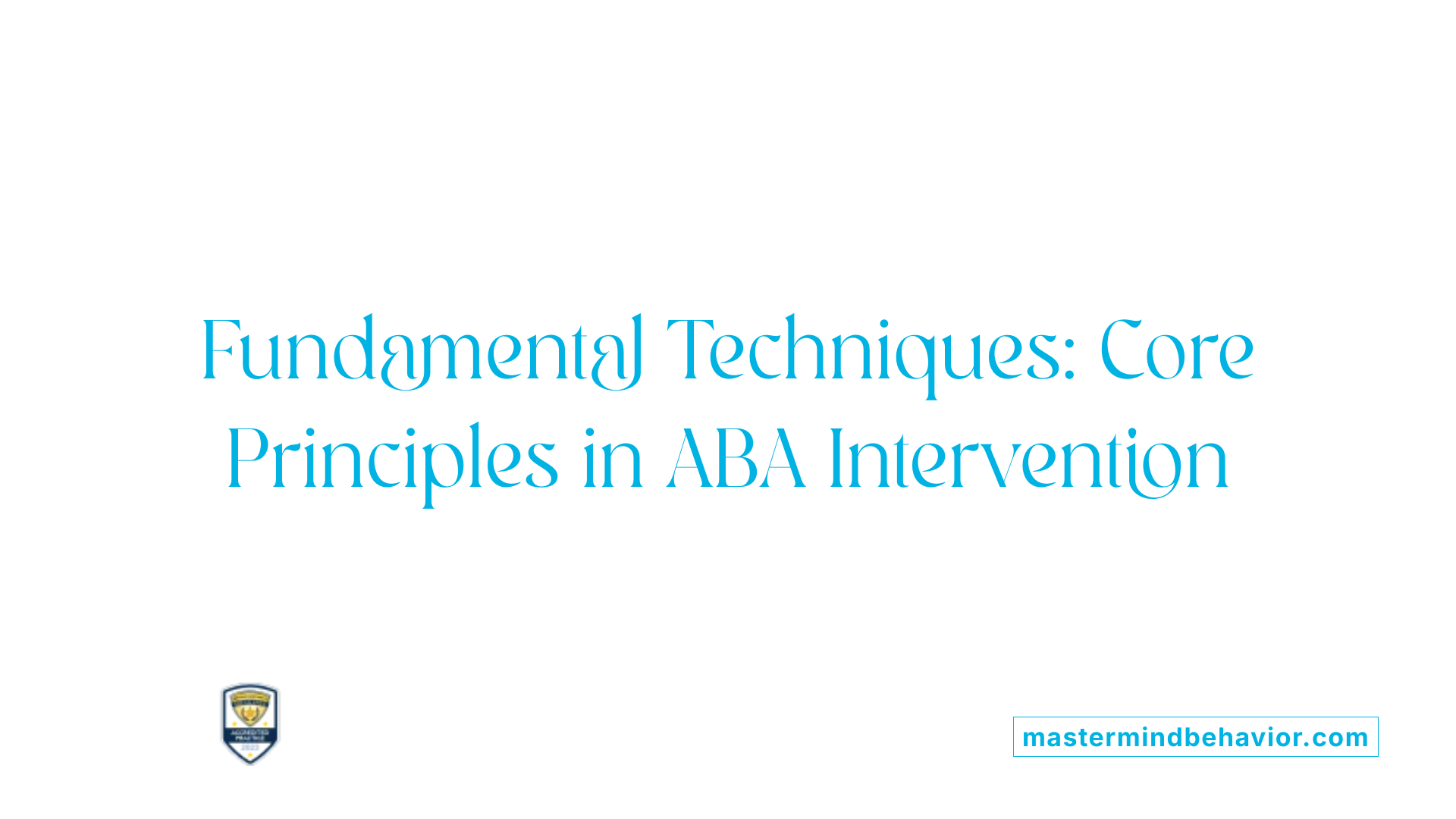Understanding Supervision in ABA Therapy
Applied Behavior Analysis (ABA) therapy is a cornerstone intervention for individuals with autism, relying heavily on skilled professionals to deliver personalized treatment. Among these professionals, Behavior Technicians (BTs) and Registered Behavior Technicians (RBTs) play critical roles in direct therapy delivery. However, their effectiveness is closely tied to proper supervision by qualified behavior analysts. This article explores what parents need to know about the supervision requirements for BTs and RBTs to ensure high-quality, ethical, and effective ABA services for their children.
Foundations of ABA Therapy and the Role of BTs and RBTs

What is Applied Behavior Analysis (ABA) therapy and how is it used to support individuals with autism?
Applied Behavior Analysis (ABA) therapy is a scientifically validated approach to understanding and changing behavior. It focuses on analyzing how behavior interacts with the environment to encourage positive change. ABA helps individuals with autism by increasing helpful behaviors like communication and social skills, while reducing behaviors that interfere with learning or daily functioning.
The therapy uses strategies such as positive reinforcement, prompting, and analyzing antecedents and consequences to teach new skills. ABA programs are highly individualized, relying on ongoing data collection and assessments to ensure that interventions meet each person's unique needs. This flexibility allows ABA to be used across various settings including home, school, and community, making it accessible and effective for learners of all ages.
How BTs and RBTs fit within the ABA service model
Behavior Technicians (BTs) and Registered Behavior Technicians (RBTs) are frontline providers of ABA therapy. They work directly with individuals under the supervision of qualified Board Certified Behavior Analysts (BCBAs) or Board Certified Assistant Behavior Analysts (BCaBAs). The supervisory oversight ensures the therapy is implemented ethically and effectively, maintaining treatment fidelity.
BTs and RBTs carry out day-to-day treatment plans that are developed by supervisors. Their duties include applying behavior techniques, collecting data on client progress, and participating in ongoing training and supervision sessions. Regular monitoring by supervisors ensures that interventions are consistent and adaptive to each client’s evolving needs.
Qualifications and roles of BTs and RBTs
RBTs require specific certification regulated by the Behavior Analyst Certification Board (BACB). This includes completing education and training, passing a competency assessment, and receiving ongoing supervision. At least 5% of an RBT’s treatment hours must be supervised monthly through activities like direct observation, performance feedback, and skills training.
BTs may have varying qualifications but typically receive specialized training to deliver ABA strategies under supervision. Supervisors, who are qualified BCBAs or BCaBAs, ensure ethical adherence, skill development, and proper implementation of behavior plans.
Together, BTs and RBTs form a vital part of the ABA team by engaging directly with clients, applying evidence-based techniques, and helping achieve treatment goals designed to improve quality of life for individuals with autism.
Qualifications and Certification: Who Supervises BTs and RBTs?

Professional Qualifications of Supervisors (BCBAs and BCaBAs)
Supervision of Behavior Technicians (BTs) and Registered Behavior Technicians (RBTs) in ABA therapy is conducted by highly qualified professionals, primarily Board Certified Behavior Analysts (BCBAs) and Board Certified Assistant Behavior Analysts (BCaBAs). These supervisors have advanced training in applied behavior analysis, ensuring they can provide proper oversight and guide therapy consistent with ethical and evidence-based standards.
Certification Standards for RBTs
RBTs are certified paraprofessionals who deliver ABA services under the close supervision of BCBAs or BCaBAs. The Behavior Analyst Certification Board (BACB) mandates that RBTs receive at least 5% of their monthly working hours under supervision. This supervision involves direct observation, performance feedback, skill training, and data review to maintain high-quality intervention delivery.
Educational and Licensure Requirements for Supervisors
Supervisors must hold valid BCBA or BCaBA certifications, which require completing rigorous education, training, and supervised practical experience. Additionally, supervisors comply with state licensure regulations where applicable, ensuring legal and professional accountability. They are responsible for maintaining their credentials, ethical practice, and ongoing professional development.
Role and Responsibility of Supervisors in Ethical Compliance
Supervisors play a critical role in upholding ethical standards in ABA therapy. They ensure BTs and RBTs provide interventions that are effective, individualized, and respectful to clients. Supervision includes regular monitoring, documentation of sessions, and clear communication among therapists, families, and other stakeholders. Failure to meet supervision requirements risks certification lapses and potential legal consequences.
Who provides ABA therapy and what qualifications do professionals typically have?
ABA therapy is provided by qualified professionals such as BCBAs, educational psychologists, and therapists specializing in behavior analysis. These professionals hold advanced certifications and state licenses, ensuring appropriate expertise. QAS providers and individual practitioners must demonstrate proper supervision and ongoing assessment, maintaining valid insurance and compliance with conduct standards. ABA providers are extensively trained in evidence-based behavioral techniques, with their qualifications verified through professional and state standards to guarantee quality care.
Supervision Requirements: Standards and Best Practices for Oversight
What Are the Minimum Supervision Hours Required by the BACB?
The Behavior Analyst Certification Board (BACB) mandates that Registered Behavior Technicians (RBTs) receive supervision for at least 5% of their working hours monthly. This means for every 100 hours of direct Applied Behavior Analysis (ABA) therapy provided, a minimum of 5 hours must be dedicated to supervision activities. This standard ensures ongoing monitoring and quality assurance.
What Types of Supervision Sessions Are Provided?
Supervision can occur through individual or group sessions:
Individual sessions: Personalized one-on-one oversight with a Board Certified Behavior Analyst (BCBA) or Board Certified Assistant Behavior Analyst (BCaBA).
Group sessions: Conducted with up to 10 RBTs or Behavior Technicians, fostering collective learning and peer support.
Both formats aim to maintain high standards of care while optimizing resource utilization.
What Activities Are Included in Supervision?
A comprehensive supervision session involves multiple components:
- Direct observation: Supervisors watch therapy sessions to verify accurate implementation of behavior plans.
- Performance feedback: Constructive discussions guide technicians to refine skills and strategies.
- Behavioral skills training: Targeted instruction enhances competency in specific ABA techniques.
- Data review: Analyzing collected data to ensure interventions remain effective and aligned with treatment goals.
How Is Documentation and Compliance Managed?
Proper documentation is crucial for accountability and legal compliance. Supervisors maintain detailed logs and session notes capturing:
- Dates and duration of supervision
- Activities conducted
- Feedback provided
- Progress notes
This documentation supports certification requirements and protects against potential liabilities.
What Are the Consequences of Inadequate Supervision?
Failing to meet supervision standards can have serious repercussions, including:
- Lapses in RBT certification
- Ethical violations
- Compromised therapy quality
- Potential legal liabilities for providers
Adhering to supervision guidelines is therefore essential to uphold professional integrity and ensure optimal outcomes for individuals receiving ABA therapy.
Ensuring Ethical and Quality Assurance in ABA Service Delivery

Supervisors’ Responsibility to Enforce Ethical Standards
Supervisors in ABA services, typically qualified BCBAs or BCaBAs, carry the vital responsibility of ensuring that all practices align with established ethical standards. They oversee the development of skills in Behavior Technicians (BTs) and Registered Behavior Technicians (RBTs), monitor the proper implementation of behavior intervention plans, and maintain ongoing communication with providers and families to protect client welfare.
Maintaining Treatment Fidelity Through Ongoing Monitoring
To guarantee that ABA therapies are delivered effectively, supervision includes regular monitoring activities such as direct observation and performance feedback. Supervisors also facilitate behavioral skills training and maintain individualized treatment plans that adapt based on continuous assessment results.
Data Collection and Its Role in Quality Assurance
Systematic data collection is a cornerstone of quality in ABA treatment. Supervisors guide the collection and review of data related to client progress and treatment fidelity. This ongoing documentation ensures interventions are effective and supports necessary treatment modifications.
Addressing Legal and Certification Risks Related to Poor Supervision
Noncompliance with supervision requirements can result in serious consequences, including lapses in RBT certification, unethical practices, and potential legal liabilities. Proper documentation of supervision hours, including logs and session notes, is essential to maintain certification and uphold clinical standards.
Individualized Treatment Plans and Dynamic Supervision Influence

What is the importance of custom treatment plans?
Individualized treatment plans are foundational in Applied Behavior Analysis (ABA) therapy for autism. Each plan is tailored to the unique needs and abilities of the person receiving therapy. These plans are created using comprehensive assessments, including functional behavior assessments, skill-based assessments, and standardized measures to guide effective intervention strategies. Customizing treatment ensures that goals are meaningful and targeted, addressing behaviors that support improved communication, social skills, learning, and independence.
Why is continuous assessment and data-driven adjustment necessary?
ABA therapy emphasizes ongoing data collection to monitor progress carefully. Regular assessment allows providers to measure the effectiveness of interventions and make evidence-based modifications when goals are met or new challenges emerge. Continuous tracking ensures that the treatment stays responsive and relevant, adapting to the individual’s evolving needs over time. This dynamic process maximizes therapeutic outcomes and promotes lasting improvements.
How does supervision support adaptation of ABA programs to individual needs?
Supervision by qualified Board Certified Behavior Analysts (BCBAs) or Board Certified Assistant Behavior Analysts (BCaBAs) plays a critical role in the successful delivery of individualized ABA programs. Supervisors oversee the implementation of treatment plans, providing feedback after direct observations, reviewing collected data, and conducting behavioral skills training with Registered Behavior Technicians (RBTs). This structured oversight guarantees adherence to ethical standards and promotes consistent quality in therapy. Regular supervision meetings also facilitate communication between therapists, supervisors, and families, ensuring all stakeholders contribute to and understand treatment adjustments. Ultimately, supervision supports responsive and flexible interventions that meet each individual’s growth and challenges effectively.
Typical ABA Therapy Sessions Delivered by BTs and RBTs Under Supervision
What does a typical ABA therapy session look like?
A typical ABA therapy session is a carefully structured, individualized interaction lasting around 2 to 4 hours. During this time, Behavior Technicians (BTs) and Registered Behavior Technicians (RBTs) work one-on-one with the individual, focusing on personalized goals derived from comprehensive assessments and ongoing data collection.
Structure and goals of ABA sessions
Each session includes skill-building exercises, social skills practice, play activities, and training for daily living skills. These activities are designed to promote meaningful progress in communication, social interaction, behavior management, and functional abilities. Visual supports and natural environment teaching methods are often incorporated to make learning relevant and applicable to real-world situations.
Incorporation of techniques such as positive reinforcement and behavior analysis
Positive reinforcement is a cornerstone of these sessions, where desired behaviors are encouraged through rewards such as praise, tokens, or access to preferred activities. Therapists utilize the A-B-C (Antecedent-Behavior-Consequence) framework to analyze behavior triggers and outcomes, enabling them to refine strategies that increase helpful behaviors and reduce challenging ones.
How BTs and RBTs apply supervision feedback to improve sessions
BTs and RBTs receive ongoing supervision from qualified BCBAs or BCaBAs, who monitor their sessions through direct observation, performance feedback, and data review. This supervision ensures adherence to ethical standards and the fidelity of behavior intervention plans. The therapists integrate supervisor feedback by adjusting intervention strategies, improving data collection accuracy, and enhancing communication techniques.
Parental involvement and communication in sessions
Family involvement is critical, with providers encouraging open and consistent communication between therapists, supervisors, and families. Parents receive training to carry over strategies outside therapy sessions, fostering skill generalization. Regular updates about progress and challenges help align efforts and optimize therapy outcomes across settings.
| Aspect | Description | Role of BTs/RBTs |
|---|---|---|
| Session Duration | Typically 2-4 hours focusing on individualized goals | Deliver direct therapy and collect data |
| Techniques Used | Positive reinforcement, A-B-C analysis, prompting, fading | Implement strategies and adjust based on supervision |
| Supervision | At least 5% of working hours supervised monthly by BCBAs/BCaBAs | Receive feedback and training to improve skills |
| Family Communication | Regular updates, training, and involvement in treatment planning | Facilitate communication and support generalization |
| Data Collection | Ongoing tracking of behavior, skill acquisition, and intervention effectiveness | Record and report accurate data to supervisors |
Core Behavioral Principles and Techniques Applied by Supervised BTs and RBTs

What are the core principles and techniques involved in ABA therapy for autism?
Applied Behavior Analysis (ABA) is a scientific method focused on changing behavior through careful analysis of environmental factors. At its heart is positive reinforcement, where behaviors followed by rewarding consequences are more likely to happen again. ABA uses the A-B-C framework: Antecedent (what happens before a behavior), Behavior (the behavior itself), and Consequence (what happens after), to understand and teach new skills.
Common ABA techniques employed by supervised Behavior Technicians (BTs) and Registered Behavior Technicians (RBTs) include:
- Prompting and Fading: Helping individuals perform new tasks with guidance that is slowly removed as they gain independence.
- Chaining: Breaking down complex behaviors into smaller steps and teaching them in sequence.
- Discrete Trial Training: Structured teaching sessions that break skills into small, teachable units.
- Modeling: Demonstrating desired behaviors for imitation.
- Extinction and Redirection: Reducing unwanted behaviors by withholding reinforcement and providing alternative responses.
These techniques are tailored through individualized treatment plans, which BTs and RBTs implement under the supervision of qualified Board Certified Behavior Analysts (BCBAs) or Board Certified Assistant Behavior Analysts (BCaBAs). Supervised technicians collect data and monitor progress to ensure interventions remain effective and ethically sound.
The ultimate goal of ABA is to increase functional, helpful behaviors such as communication, social skills, and learning abilities while decreasing behaviors that impede learning or cause harm. Supervised BTs and RBTs play a crucial role in delivering these evidence-based interventions consistently and reliably, ensuring each individual receives therapy customized to their unique needs.
Effectiveness of ABA Therapy and the Impact of Quality Supervision
How effective is ABA therapy in improving outcomes for individuals with autism?
Applied Behavior Analysis (ABA) therapy is widely recognized as an effective, evidence-based treatment for Autism Spectrum Disorder (ASD). Backed by over 20 rigorous scientific studies and acknowledged by the US Surgeon General and the American Psychological Association, ABA has demonstrated significant success in improving communication, social skills, adaptive behaviors, and reducing problem behaviors in individuals with autism.
Studies consistently show that early, intensive ABA interventions—typically around 10 to 20 hours per week and sometimes higher—lead to considerable gains, especially in young children. These gains include measurable improvements in social/emotional functioning, language development, and daily living skills. Crucially, therapy involves individualized treatment plans built on comprehensive assessments, ensuring goals meet each individual's unique needs.
Parental involvement and generalization of skills to natural environments such as home, school, and community settings are essential to sustain progress. Although outcomes vary based on individual differences, therapy quality, and consistency, ABA has proven to be a transformative approach that enhances quality of life and promotes independence.
Why are early, intensive, and supervised interventions important?
Early intervention is vital because younger children often demonstrate the most rapid behavioral improvements. Higher intensity treatment—sometimes 30 to 40 hours weekly—can further optimize outcomes by reinforcing learning and promoting skill acquisition.
Equally important is structured supervision from qualified professionals like Board Certified Behavior Analysts (BCBAs) or Board Certified Assistant Behavior Analysts (BCaBAs). Supervision ensures the therapy is delivered with fidelity to evidence-based practices, adherence to ethical standards, and frequent adjustments based on ongoing data collection and assessment.
Supervised interventions benefit from:
- Regular monitoring and feedback
- Behavioral skills training for ABA providers
- Accurate data review to track progress
- Adaptation of strategies to meet emerging needs
These components help maximize treatment effectiveness and minimize risks such as inconsistent implementation or drift from protocols.
How does supervision influence therapy effectiveness and client progress?
Supervision plays a critical role in maximizing the impact of ABA therapy. Registered Behavior Technicians (RBTs) who implement direct therapy are required by the Behavior Analyst Certification Board (BACB) to receive at least 5% of their working hours supervised monthly. This supervision can be individual or in small groups (up to 10 participants) and includes:
- Direct observation of the RBT’s delivery of therapies
- Performance feedback and coaching
- Behavioral skills training sessions
- Reviewing collected data to ensure progress and fidelity
Qualified supervisors—either BCBAs or BCaBAs—ensure ethical standards and evidence-based approaches are consistently applied. Proper documentation of supervision sessions is maintained to support accountability.
Research supports that therapists working under consistent, quality supervision deliver more effective interventions, resulting in better client outcomes. Without adequate supervision, risks include reduced treatment efficacy, ethical concerns, potential certification lapses, and legal liabilities.
Overall, the synergy of research-backed ABA methods combined with robust, skilled supervision constitutes the foundation for achieving meaningful and lasting improvements for individuals with autism.
Parental Role and Communication in Supervised ABA Therapy
Why is clear communication between families and providers essential in ABA therapy?
Effective ABA therapy relies heavily on open and consistent communication between families and providers. Clear communication ensures that parents and caregivers understand treatment goals, strategies used, and progress made, fostering a collaborative environment that supports the child’s development. It also helps families stay informed about any adjustments in therapy plans, making them active partners in the intervention process.
How do supervisors facilitate family involvement and ongoing training?
Supervisors, typically qualified BCBAs or BCaBAs, play a vital role in bridging communication between behavior technicians and families. They provide regular updates, explain techniques, and offer guidance to caregivers through training sessions. These opportunities equip families with the knowledge and skills needed to support their child’s development outside of therapy sessions, ensuring consistent implementation of ABA strategies across settings.
How is alignment on treatment goals and progress maintained?
Regular supervision sessions include discussions on individualized treatment plans and data analysis, allowing supervisors to share concrete progress updates with families. This ongoing dialogue helps align everyone's expectations and allows treatment adjustments based on functional assessments and real-time data. Maintaining this alignment optimizes outcomes and ensures the therapy remains responsive to the child’s evolving needs.
Critiques and Ethical Considerations in ABA and Supervision Practices
Are there any criticisms or controversies associated with ABA therapy?
ABA therapy, while grounded in decades of scientific research and recognized as effective by major health organizations, has faced notable criticisms. One common concern is that ABA can sometimes be overly rigid or focus heavily on compliance, which critics say may restrict an individual's autonomy and self-expression. Additionally, the structured and intense nature of some ABA interventions could lead to discomfort or a lack of consideration for the individual's personal preferences.
Importance of ethical, person-centered practice enforced through supervision
To address these concerns, ethical standards enforced through careful supervision are vital. Supervisors, who are qualified BCBAs or BCaBAs, are responsible for ensuring that ABA services remain person-centered and respectful. This includes ongoing monitoring, data review, and adapting treatment plans to meet the unique needs of each individual. Ethical practice in ABA demands that therapy promote meaningful, positive changes without compromising the dignity or preferences of those receiving services.
Balancing therapy structure with respect for individual preferences
The structure inherent in ABA is necessary to ensure consistent, measurable progress, but it must be balanced with flexibility that honors the individual's desires and comfort. Effective supervision encourages collaboration with families and clear communication to create individualized treatment plans. By continuously assessing and adjusting interventions, ABA practitioners can maintain this balance, fostering a supportive environment that respects individual autonomy while delivering evidence-based therapy.
| Aspect | Concern/Criticism | Ethical Response & Best Practice |
|---|---|---|
| Focus on Compliance | May limit autonomy and self-expression | Emphasize person-centered planning and respect preferences |
| Intensity and Structure | Could cause discomfort or inflexibility | Adjust treatment intensity; ongoing assessment and feedback |
| Implementation and Oversight | Risk of unethical or rigid practice | Rigorous supervision by qualified BCBAs/BCaBAs ensuring ethical standards |
By openly acknowledging critiques and embedding ethics into supervision and practice, ABA therapy can continue evolving as a respectful and effective intervention tailored to each individual's needs.
Ensuring Optimal Outcomes Through Quality Supervision
Supervision of Behavior Technicians and Registered Behavior Technicians is a fundamental component of delivering effective, ethical ABA therapy for individuals with autism. Qualified supervisors ensure that ABA interventions adhere to evidence-based practices, ethical guidelines, and are continuously tailored to each client’s evolving needs. For parents, understanding how BT and RBT supervision functions offers reassurance that the care provided is accountable, professional, and designed to maximize positive outcomes. As ABA therapy continues to advance, maintaining rigorous supervision standards remains critical to supporting the real-life progress and independence of those receiving services.
References
- Applied Behavior Analysis Treatment of Autism Spectrum ...
- RBT Supervision Requirements What You Need to Know
- Applied Behavior Analysis Practice Guidelines for the ...
- Applied Behavior Analysis (ABA)
- The effectiveness of applied behavior analysis program ...
- Applied Behavior Analysis (ABA)
- Efficacy of Interventions Based on Applied Behavior ...
- The Controversy Around ABA









